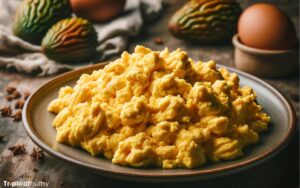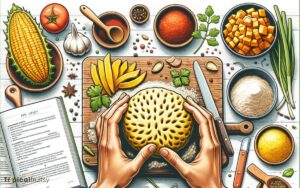How to Make Ackee and Saltfish and Dumplings? 5 Easy Steps!
Ackee and saltfish, paired with dumplings, is a quintessential Jamaican dish revered for its unique blend of flavors and textures.
This culinary delight begins with the preparation of saltfish, a preserved cod that must be adequately desalted to achieve the desired taste balance.
Ackee, the national fruit of Jamaica, requires careful handling to preserve its delicate nature during the cooking process. The dumplings, a staple in Caribbean cuisine, add a satisfying heartiness to the meal.
In crafting this dish, one must procure quality ingredients and employ precise techniques to ensure authenticity.
This guide offers a step-by-step approach to creating this traditional meal, ensuring that cooks of all levels can savor and serve a dish that pays homage to its rich cultural roots.
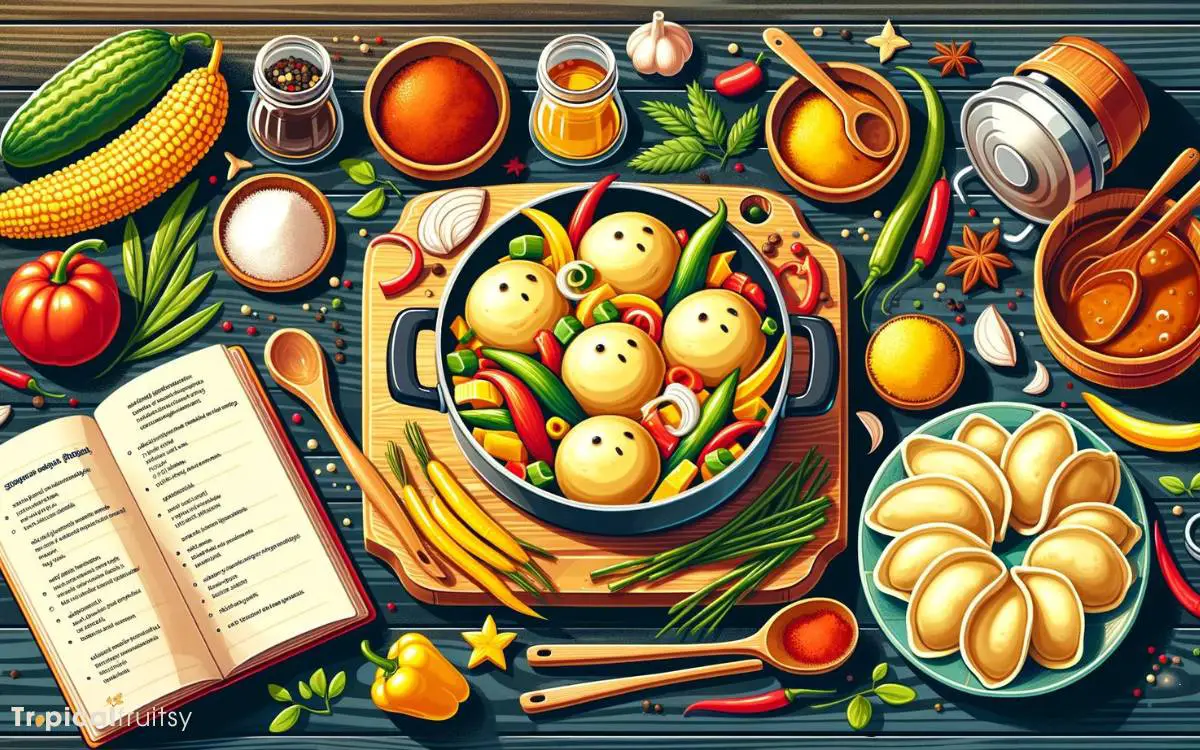
Key Takeaway
Gathering Your Ingredients
To prepare Ackee and Saltfish with Dumplings, it is essential to procure the following ingredients:
- Canned ackee
- Salted codfish
- Flour
- Spices
- Additional components for the dumpling mixture
In the pursuit of authenticity, select the finest quality ackee, ensuring it’s firm yet tender to the touch. The salted codfish, a staple in Caribbean cuisine, must be of superior grade to impart the quintessential savory depth.
Flour, the foundation of the dumplings, should be all-purpose, unbleached for a hearty texture. Spices such as scotch bonnet pepper, thyme, and black pepper will contribute the traditional aromatic profile.
With the ingredients assembled, the stage is set to begin transforming the salted codfish into the succulent centerpiece of this beloved dish.
Step 1: Preparing the Saltfish
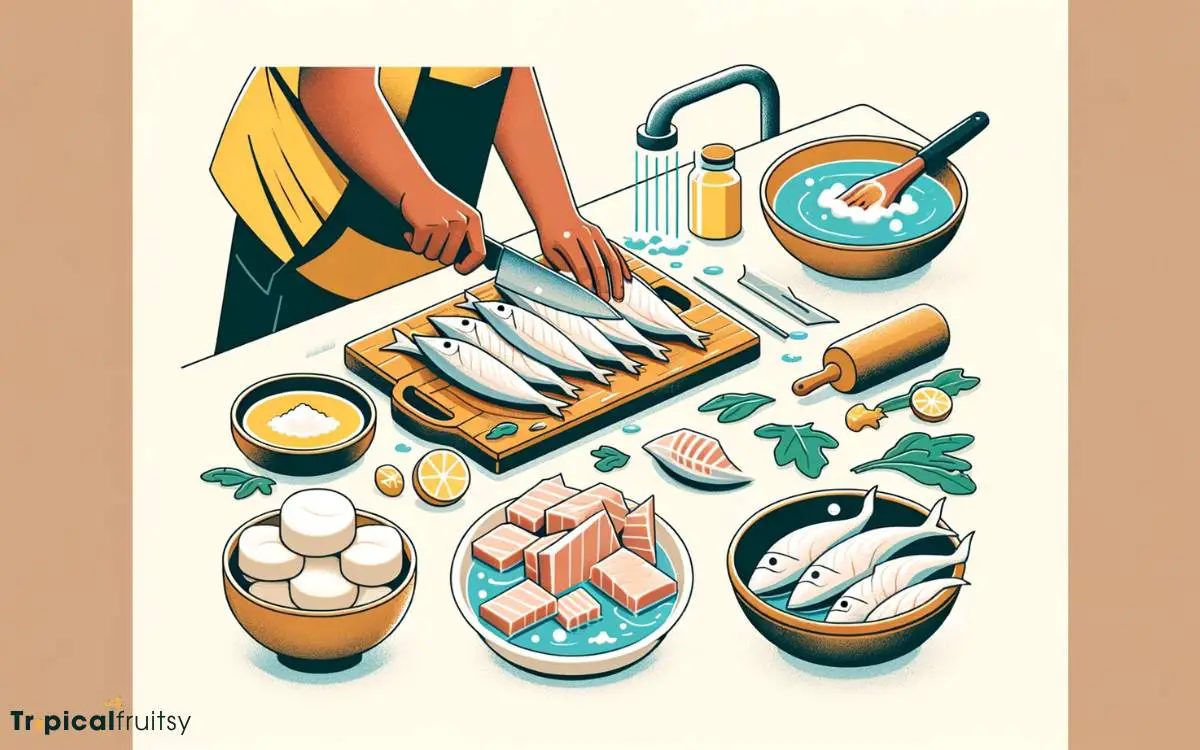
Commencing with the desalting process, the salted codfish must be soaked in water overnight to temper its salinity and ensure the optimal balance of flavors.
This step is crucial for achieving the authentic taste that characterizes traditional Ackee and Saltfish. The water should be changed several times to facilitate the removal of excess salt.
Once soaked, the saltfish is then gently simmered until tender—a step that further mellows its robust salty bite.
Below is a table to guide you through the preparation stages:
| Stage | Description | Duration |
|---|---|---|
| Soaking | Submerge saltfish in cold water | Overnight |
| Water Change | Replace water to remove more salt | 2-3 times |
| Simmering | Cook saltfish in fresh water | 20-25 minutes |
| Checking | Test for desired saltiness | As needed |
| Flaking | Break into bite-size pieces | After cooling |
Follow these steps carefully for a saltfish that is perfectly seasoned and ready to be sautéed with the vibrant flavors of Jamaica’s national dish.
Step 2: Cooking the Ackee
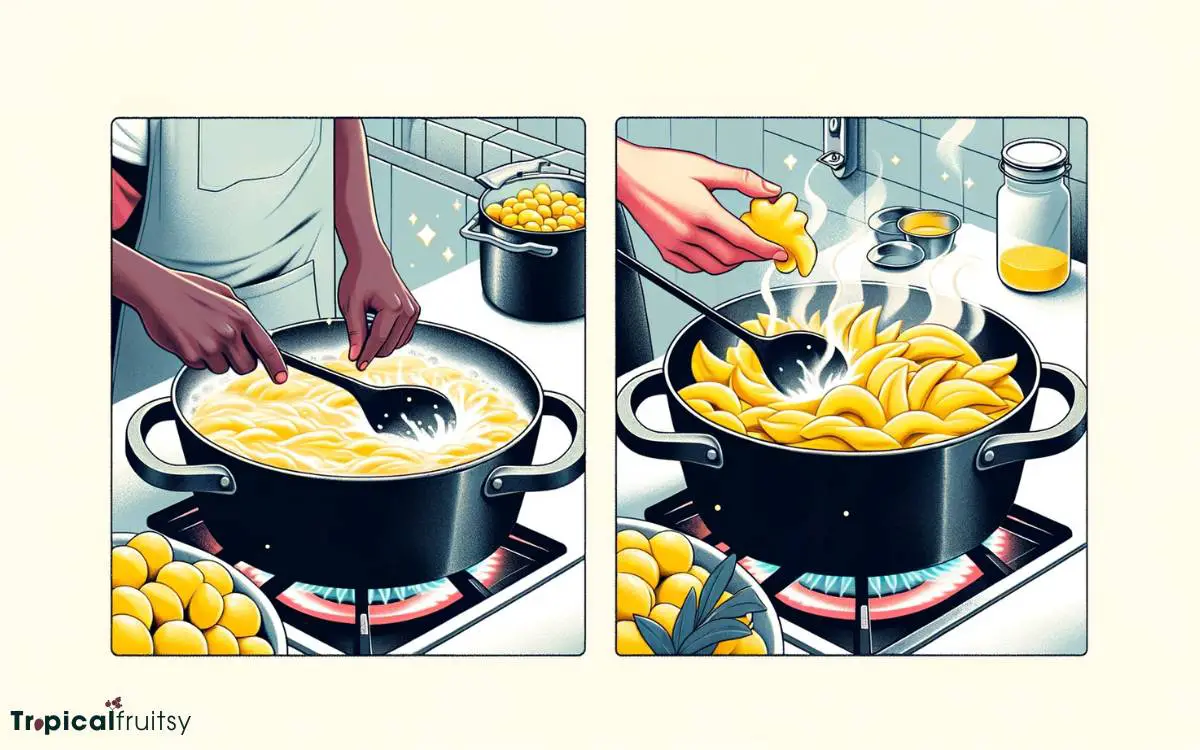
Turning our attention to the ackee, the heart of our dish, we embrace the delicate process that ensures its rich, creamy texture.
Mindful preparation and gentle cooking are paramount to preserving the integrity of this revered fruit.
We shall explore the nuances of achieving the perfect consistency and seasoning that pay homage to this staple of Caribbean cuisine.
Proper Ackee Preparation
Each can of ackee must be carefully drained and rinsed before it is gently simmered to preserve its delicate texture.
This cherished fruit, central to the Jamaican culinary heritage, requires a respectful touch to maintain its integrity from can to plate.
Here is how you honor the tradition:
Draining and Rinsing
- Remove ackee from can: Pour off the brine to rid the ackee of excess salt.
- Rinse under cold water: Wash away any remaining brine to ensure a clean taste.
Gentle Simmering
- Simmer in water: Place ackee in a saucepan with enough water to cover.
- Cook until just tender: Watch carefully; overcooking can cause it to become mushy.
Treat ackee with the reverence it deserves, and it will grace your dish with its full, natural flavor.
Achieving Ideal Texture
Upon reaching a tender state, the ackee should be carefully removed from the heat to prevent overcooking, ensuring its prized texture is preserved for the dish.
The fruit’s delicate balance teeters between firm and mushy; it should yield to the slightest nudge yet maintain its distinctive shape.
In the dance of heat and time, patience is the chef’s silent partner. Stirring should be done with a gentle hand, as the soft, buttery flesh of the ackee is prone to breaking apart if agitated too vigorously.
This is the moment where culinary finesse meets traditional respect for the ingredient’s integrity.
The ackee now stands ready to imbibe the surrounding flavors, segueing seamlessly into the art of seasoning, where each spice and herb plays its pivotal role.
Seasoning Balance Tips
Achieving the perfect seasoning blend is crucial to honor the ackee’s subtle flavors without overwhelming its natural taste.
When cooking ackee, one must approach seasoning with a delicate hand, ensuring that each spice and herb complements the dish’s main components.
Traditional Jamaican cooking values the harmony of flavors, and the ackee must be allowed to shine amidst the seasoning.
Seasoning for Ackee:
- Start with a base of finely chopped onions, garlic, and scotch bonnet pepper for a piquant foundation.
- Incorporate dried thyme, a staple in Jamaican cuisine, to add depth.
Balancing the Blend:
- Use salt sparingly, as the saltfish already carries salinity.
- Gently fold the seasonings into the ackee to preserve its delicate texture and avoid crushing the soft fruit.
Step 3: Making the Dumplings
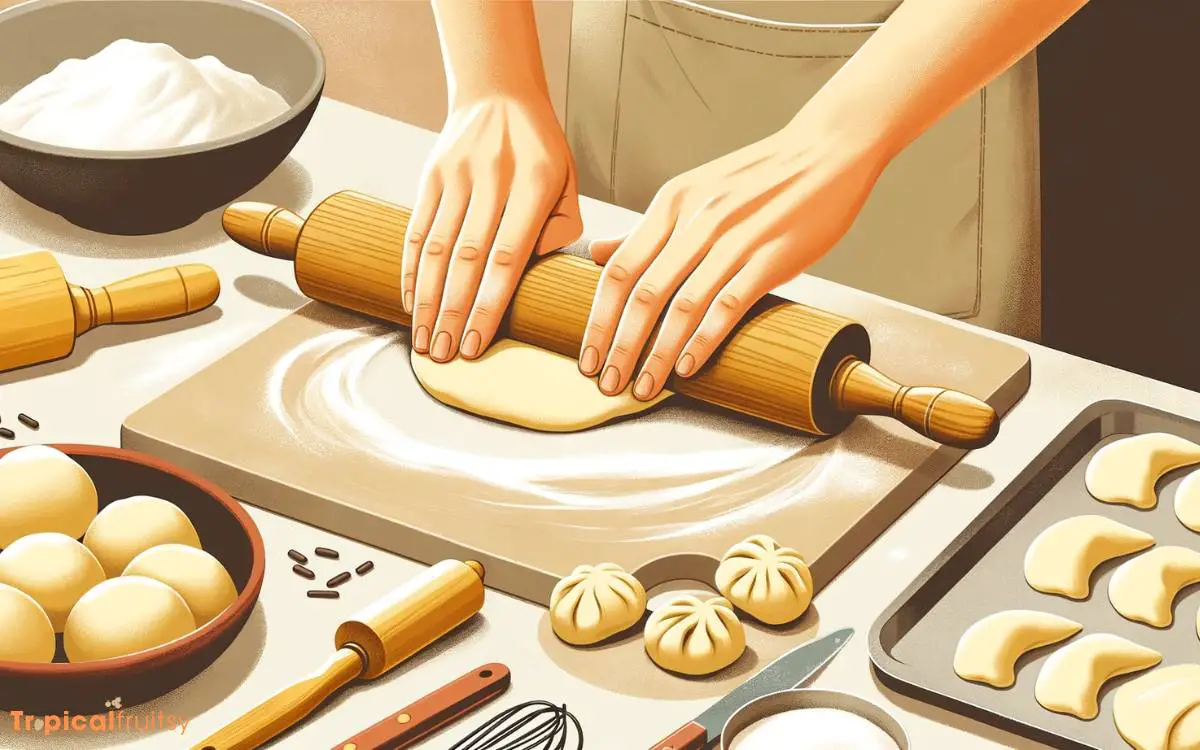
Having prepared the ackee and saltfish, we now turn our attention to crafting the perfect dumplings to accompany this classic Caribbean dish.
The art of dumpling making is steeped in tradition, requiring simple, humble ingredients to create a soul-warming complement. Begin with a mixture of all-purpose flour and a pinch of salt for a touch of seasoning.
Gradually incorporate water, kneading gently to form a smooth, pliable dough. The texture is paramount; it should be firm but not stiff, tender to the touch, yet resilient.
Once the dough reaches the desired consistency, divide it into equal portions, rolling each piece between your palms to form a ball. Then, lightly press to flatten slightly, creating the iconic dumpling shape.
These doughy pillows, once boiled or fried, will offer a satisfyingly chewy texture, a delightful contrast to the delicate ackee and robust saltfish.
Step 4: Combining the Dish
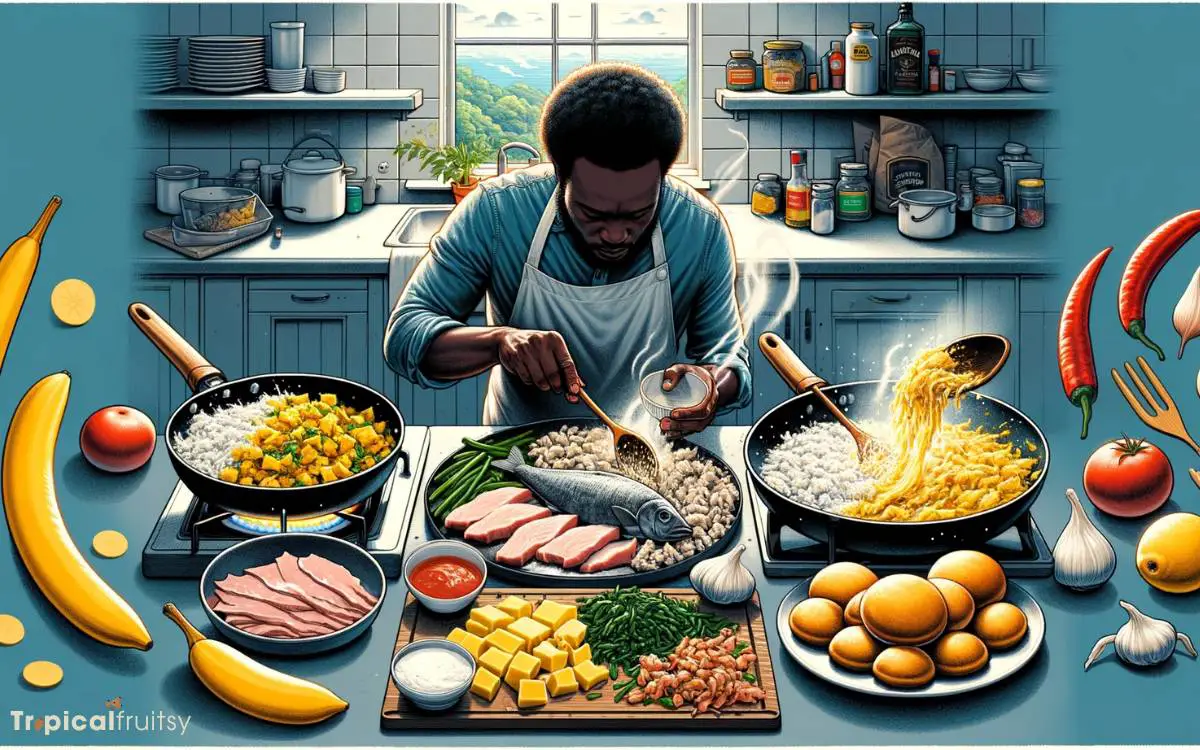
As we approach the final steps of crafting our Ackee and Saltfish with Dumplings, the art of marrying flavors and textures becomes paramount.
Careful attention to the harmony of spice and the gentle yielding of the ackee to the robust saltfish sets the stage for a traditional culinary experience.
Timing is of the essence, ensuring each component reaches its peak of perfection to create a dish that resonates with the soul of the islands.
Flavor Balancing Techniques
In combining ackee and saltfish with dumplings, it is important to consider the delicate balance of flavors to ensure a harmonious dish.
The rich, savory taste of the saltfish must complement the subtly sweet and creamy texture of the ackee, while the dumplings provide a satisfying contrast.
Saltfish Preparation:
- Soak to reduce saltiness, enhancing the natural fish flavor.
- Sauté with onions, garlic, and Scotch bonnet pepper for a spicy undertone.
Ackee Integration:
- Gently fold in ackee to preserve its delicate texture.
- Balance the dish’s richness with a squeeze of fresh lime juice.
Executing these techniques with care ensures each bite of ackee and saltfish with dumplings is a testament to the vibrant culinary tapestry of traditional Caribbean cuisine.
Texture Contrast Importance
Mastering the art of texture contrast is crucial when combining ackee and saltfish with dumplings to create a dish that delights the palate with every bite.
The luscious softness of well-stewed ackee pairs exquisitely with the tender yet firm flakes of salt-cured fish, offering a sumptuous dance of textures.
The dumplings introduce a heartiness, their doughy resilience providing a satisfying chew that complements the tender components of the dish.
This juxtaposition of textures is not accidental but a deliberate orchestration that elevates the eating experience. It’s the careful weaving of these elements that ensures each mouthful is a harmonious symphony of the island’s culinary essence.
As we contemplate this tapestry of textures, let us pivot our attention to the finesse required in ‘cooking time coordination’.
Cooking Time Coordination
The successful combination of ackee, saltfish, and dumplings hinges on precise cooking time coordination to ensure each component reaches its ideal texture without overcooking.
Achieving the symphony of flavors and textures traditional to this dish requires an understanding of each element’s cooking needs:
Ackee:
- Gently fold into the sautéed saltfish just before serving to maintain its delicate structure.
- Cook only until it’s heated through, as it is pre-cooked in the can.
Saltfish:
- Soak overnight, boil, and flake prior to sautéing with aromatics to infuse the fish with savory depth.
- Sauté until just crisp on the edges for a textural contrast with the soft ackee.
Dumplings:
- Boil in salted water until they float to the top, indicating they’re cooked through.
- Serve immediately with the ackee and saltfish to enjoy their comforting chewiness.
Can I Use Codfish Instead of Saltfish to Make Ackee and Saltfish and Dumplings?
Certainly, you can substitute codfish for the traditional saltfish in the classic Jamaican dish. When embarking on how to cook ackee and codfish, a gentle soak and boil method can be used to reduce the codfish’s saltiness, harmonizing the flavors with the creamy texture of the ackee—presenting a delightful twist to the customary fare alongside fluffy, hand-rolled dumplings.
Step 5: Serving and Presentation
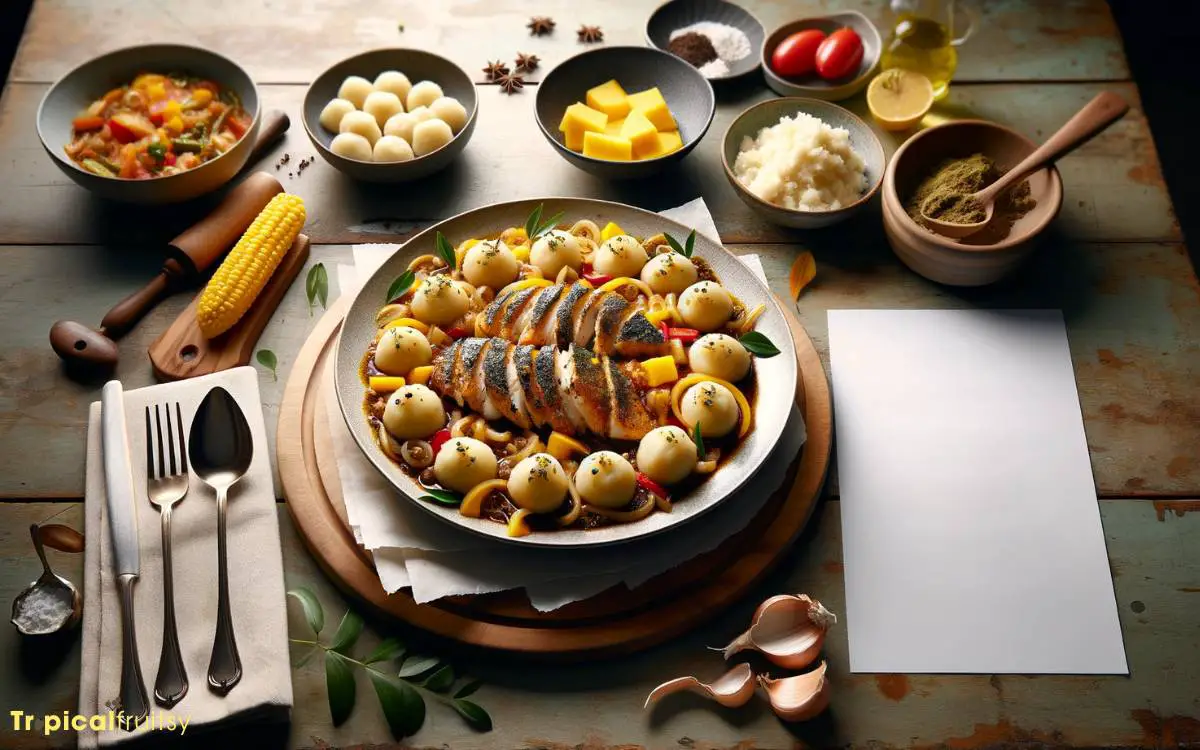
Upon completion of cooking, carefully plate the ackee and saltfish alongside warm dumplings for a visually appealing and traditional Jamaican presentation.
The rich, vibrant yellow of the ackee delicately balances the hearty, flaked saltfish, creating a tapestry of colors and textures that beckon the soul of the island to the dinner table.
The dumplings, golden-brown and tender, nestle beside the main dish, promising a satisfying complement to the savory flavors.
| Emotion | Description |
|---|---|
| Comfort | Warm dumplings symbolize a hearty welcome. |
| Nostalgia | Traditional plating awakens cherished memories. |
| Anticipation | The vibrant colors promise a flavorful journey. |
| Satisfaction | The perfect balance of textures ensures a delightful meal. |
Serve this dish with a side of love, a garnish of history, and a sprinkle of the vibrant Jamaican spirit.
Conclusion
As the culinary tapestry of Jamaica is woven with vibrant threads of history and culture, so too is the traditional dish of ackee and saltfish with dumplings.
This dish, an homage to the island’s rich heritage, offers a symphony of flavors that sing of its African and Arawak roots.
The harmonious blend of savory and delicate textures mirrors the spirit of a people—resilient, bold, and intricately connected to their storied past.




